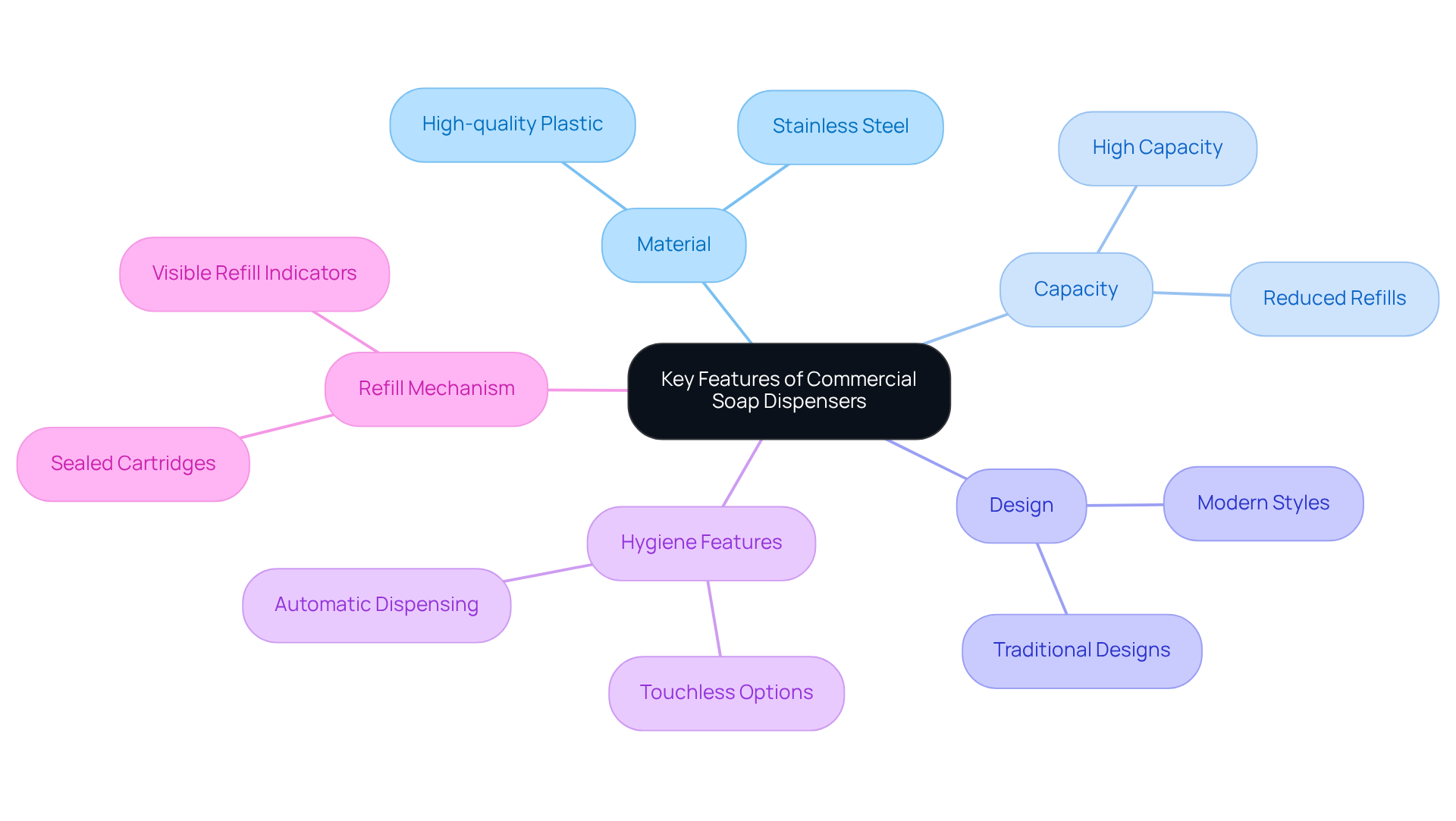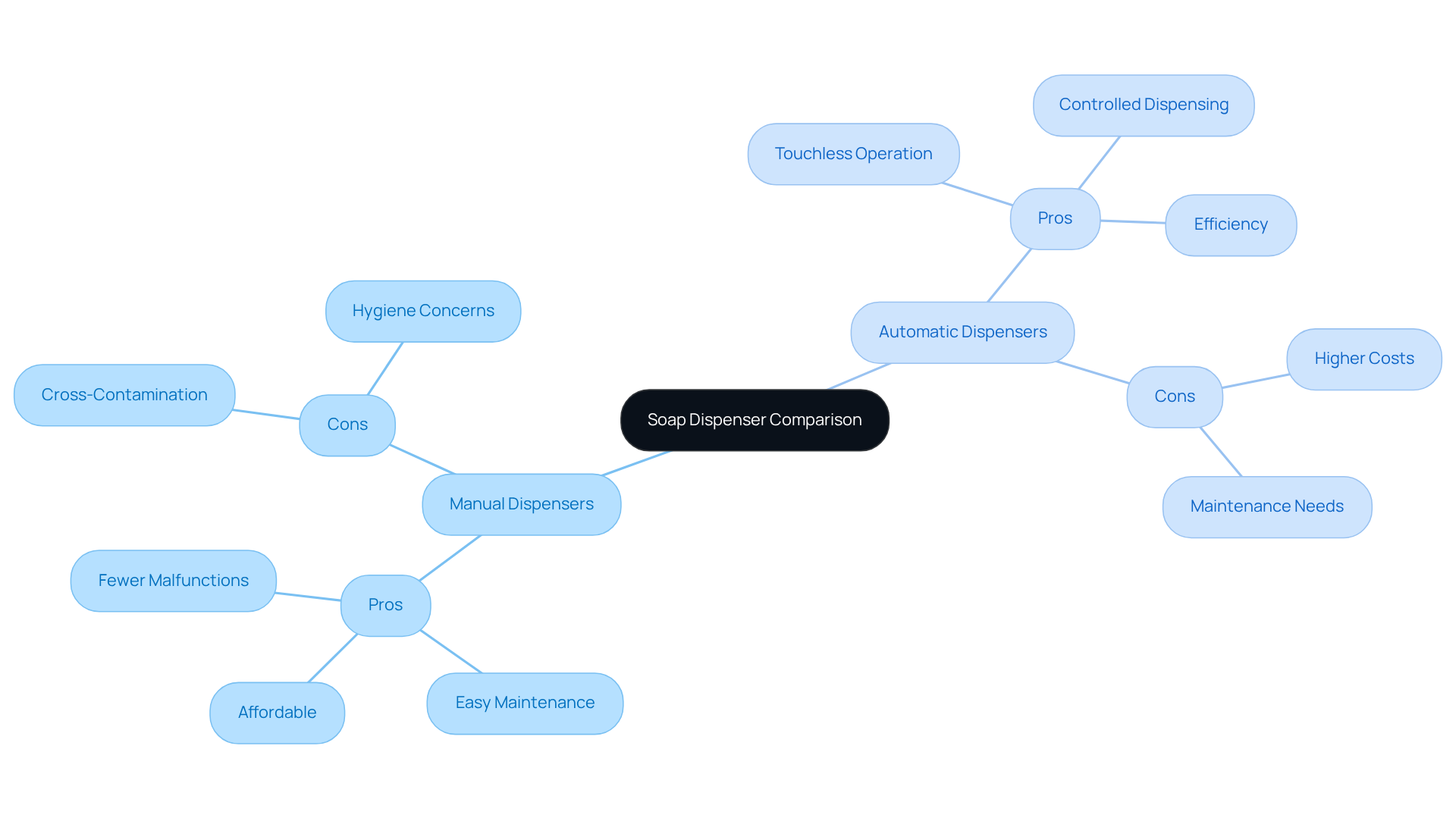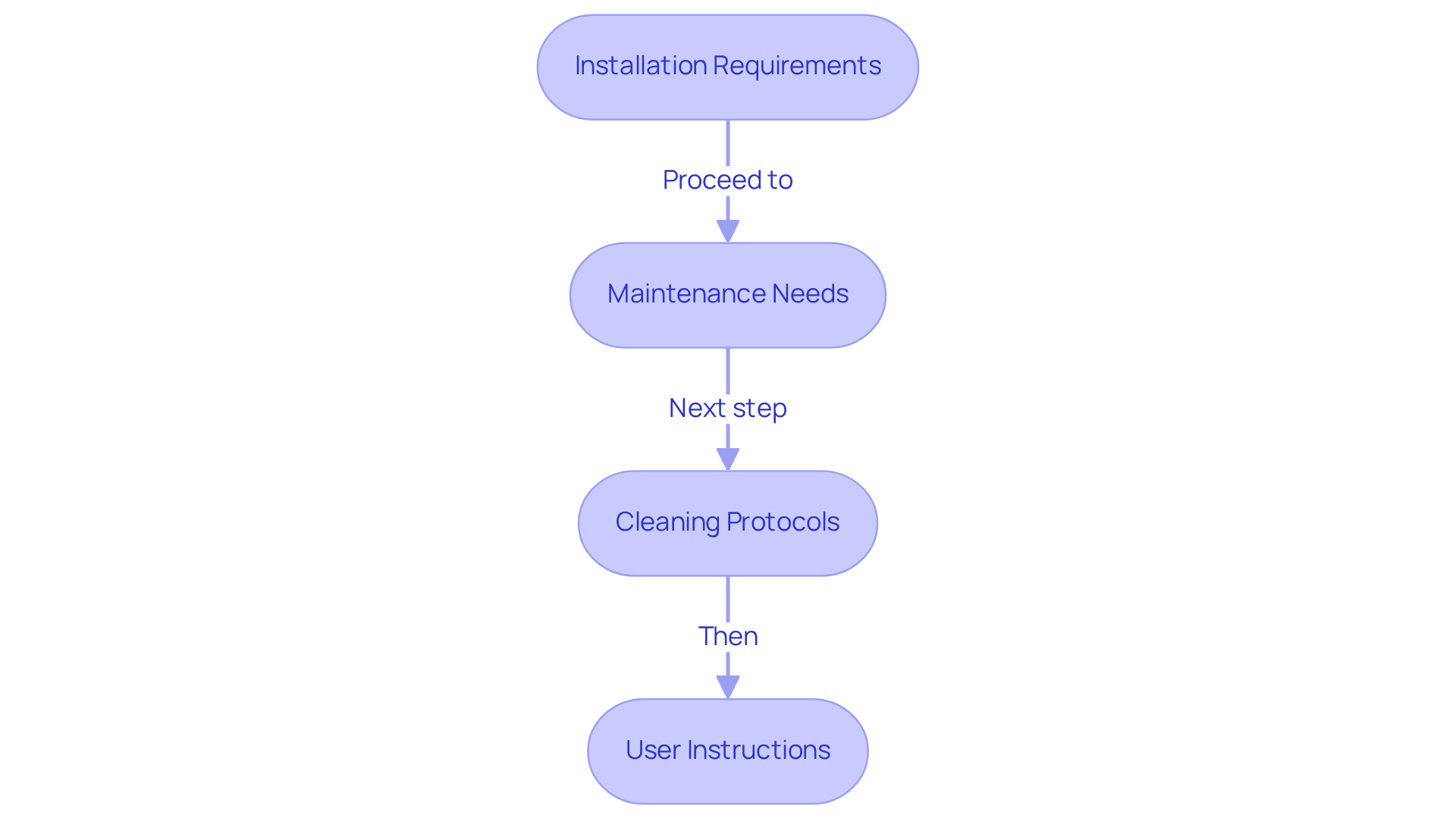Overview
The article delineates the process of selecting the appropriate commercial restroom soap dispensers through four critical steps:
- Identifying key features
- Assessing facility requirements
- Comparing dispenser types
- Evaluating installation and maintenance considerations
Each step underscores the significance of durability, hygiene, user accessibility, and maintenance efficiency, thereby supporting the overarching objective of enhancing cleanliness and user experience within commercial restrooms.
Introduction
Selecting the right commercial restroom soap dispensers is not merely a matter of convenience; it plays a crucial role in maintaining hygiene and enhancing user experience in high-traffic environments. With a growing emphasis on cleanliness and operational efficiency, understanding the key features and user needs becomes essential for any facility manager. Furthermore, navigating the myriad options available is critical to ensure that the chosen dispensers not only meet functional requirements but also align with the specific demands of their establishment.
Identify Key Features of Commercial Soap Dispensers
When selecting commercial restroom soap dispensers, it is essential to consider several key features that can significantly enhance functionality and user experience.
-
Material: Choose durable materials such as stainless steel or high-quality plastic, designed to withstand heavy use and resist corrosion. Stainless steel containers, in particular, are recognized for their durability and ease of maintenance, making them ideal for busy environments.
-
Capacity: Opt for units with larger capacities to accommodate the traffic in your facility. High-capacity commercial restroom soap dispensers help reduce the frequency of refills, which is crucial in bustling settings like hotels and public facilities, where maintaining cleanliness is paramount.
-
Design: Ensure that the unit's design complements your restroom's aesthetics. With options ranging from sleek, modern styles to more traditional designs, you can achieve seamless integration into various environments.
-
Hygiene Features: Consider touchless options that minimize contact and reduce the spread of germs. Automatic devices are increasingly favored as they enhance cleanliness by dispensing liquid without requiring physical touch. In the hospitality sector, upholding hygiene is vital, and commercial restroom soap dispensers are essential for ensuring cleanliness and minimizing cross-contamination.
-
Refill Mechanism: Evaluate the ease of refilling the container. Models with sealed cartridges help prevent contamination and ensure that the cleaning agent remains hygienic. Additionally, visible refill indicators allow staff to easily monitor supply levels, contributing to a seamless guest experience.
By focusing on these aspects, you can ensure that the liquid container not only meets functional requirements but also enhances the overall restroom experience, leading to increased guest satisfaction and operational efficiency. The global market for liquid cleaning product delivery systems was estimated at approximately USD 1.2 billion in 2023 and is projected to reach around USD 2.3 billion by 2032, underscoring the importance of selecting the right liquid delivery system in a growing market.

Assess Facility Requirements and User Needs
To effectively assess your facility's requirements and user needs for soap dispensers, follow these essential steps:
-
Evaluate Traffic Flow: Begin by analyzing the anticipated daily bathroom usage. High-traffic locations, such as shopping centers or athletic facilities, necessitate larger capacity units like commercial restroom soap dispensers to accommodate increased demand and minimize maintenance frequency. Given the heightened scrutiny over cleanliness standards in public spaces, a thorough understanding of restroom usage is crucial.
-
Consider User Demographics: Next, delve into the specific needs of your users. For instance, establishments catering to children or senior citizens may benefit from devices designed for ease of use, ensuring accessibility and promoting proper hand hygiene. Research indicates that 70% of architects and 92% of facilities experts prioritize cleanliness, underscoring the significance of understanding user needs.
-
Examine Layout: Assess the restroom layout to determine the optimal placement of equipment. Dispensers should be strategically positioned for convenient access without obstructing movement, thereby enhancing the overall user experience and encouraging cleanliness practices.
-
Identify Accessibility Needs: Ensure compliance with ADA standards by positioning devices at appropriate heights and ensuring they are user-friendly for individuals with disabilities. This consideration not only fulfills legal requirements but also fosters an inclusive environment. In the context of post-pandemic restroom design, incorporating commercial restroom soap dispensers to minimize touchpoints and adhering to CDC recommendations on hand hygiene are critical for establishing safe restroom environments.
By thoroughly evaluating these elements, you can select liquid containers that enhance user experience, promote cleanliness, and meet the specific needs of your facility.

Compare Types of Soap Dispensers: Manual vs. Automatic
When comparing manual and automatic commercial restroom soap dispensers, it is essential to evaluate their respective advantages and disadvantages.
Manual Dispensers:
- Pros: These dispensers are generally more affordable, easier to maintain, and do not require batteries or electricity. Their simpler design often results in fewer malfunctions, making them a practical choice for many facilities.
- Cons: However, they necessitate physical contact, which can lead to cross-contamination, raising hygiene concerns.
Automatic Dispensers:
- Pros: In contrast, automatic dispensers offer touchless operation, significantly reducing the risk of germ transmission and enhancing hygiene. They typically dispense a controlled amount of soap, which minimizes waste and promotes efficiency.
- Cons: On the downside, these models come with higher initial costs and may require ongoing maintenance for battery replacement or potential sensor issues.
Ultimately, the decision between manual and automatic models of commercial restroom soap dispensers should depend on your facility's hygiene standards, budget considerations, and user preferences. By weighing these factors carefully, you can make an informed choice that aligns with your operational needs.

Evaluate Installation and Maintenance Considerations
To effectively evaluate installation and maintenance considerations, adhere to the following guidelines:
- Installation Requirements: Assess whether the device necessitates specific tools or professional installation. For instance, wall-mounted units may require drilling, whereas certain models can be adhesive-mounted.
- Maintenance Needs: Reflect on the frequency with which the device will need refilling and cleaning. Opt for models that are easily accessible for maintenance staff, ensuring efficiency in upkeep.
- Cleaning Protocols: Verify that the materials utilized in the device are not only easy to clean but also resistant to staining or corrosion, thereby prolonging the lifespan of the unit.
- User Instructions: Deliver clear guidance for users on operating the device, particularly for automatic models that may necessitate specific hand positioning.
By addressing these critical considerations, you can ensure that your soap dispenser remains functional and hygienic, ultimately contributing to a positive restroom experience.

Conclusion
Selecting the appropriate commercial restroom soap dispenser is a crucial decision that profoundly influences cleanliness, user experience, and overall satisfaction within any facility. By meticulously assessing essential features such as material, capacity, design, hygiene options, and refill mechanisms, one can identify a dispenser that not only fulfills functional requirements but also elevates the restroom environment.
This article has delineated fundamental steps to facilitate the selection process, including evaluating facility requirements, comprehending user demographics, and contrasting manual versus automatic dispensers. Each of these elements is pivotal in ensuring that the selected soap dispenser aligns with both operational demands and user expectations, ultimately cultivating a hygienic and inviting restroom experience.
In light of the increasing emphasis on cleanliness and hygiene in public facilities, the significance of investing in high-quality soap dispensers is paramount. By prioritizing the right features and addressing the specific needs of users, businesses can foster an environment that champions health and satisfaction. Now is the time to assess and enhance restroom soap dispensers, as this will not only improve the user experience but also contribute to a cleaner, safer public space.
Frequently Asked Questions
What materials are recommended for commercial soap dispensers?
It is recommended to choose durable materials such as stainless steel or high-quality plastic, which can withstand heavy use and resist corrosion. Stainless steel is particularly noted for its durability and ease of maintenance.
Why is capacity important when selecting a soap dispenser?
Opting for units with larger capacities is important as it accommodates the traffic in your facility, helping to reduce the frequency of refills, which is crucial in busy settings like hotels and public facilities.
How should the design of a soap dispenser be considered?
The design of the soap dispenser should complement the restroom's aesthetics. There are various options available, ranging from sleek, modern styles to more traditional designs, allowing for seamless integration into different environments.
What hygiene features should be considered for soap dispensers?
It is advisable to consider touchless options that minimize contact and reduce the spread of germs. Automatic devices are increasingly favored as they enhance cleanliness by dispensing liquid without requiring physical touch.
What should be evaluated regarding the refill mechanism of soap dispensers?
The ease of refilling the container should be evaluated. Models with sealed cartridges help prevent contamination, while visible refill indicators allow staff to easily monitor supply levels, contributing to a seamless guest experience.
Why is selecting the right liquid delivery system important?
Selecting the right liquid delivery system is important as it enhances the overall restroom experience, leading to increased guest satisfaction and operational efficiency. The global market for these systems is projected to grow significantly, highlighting their importance.




